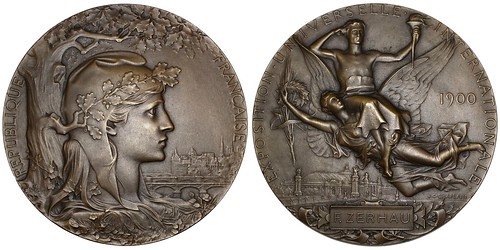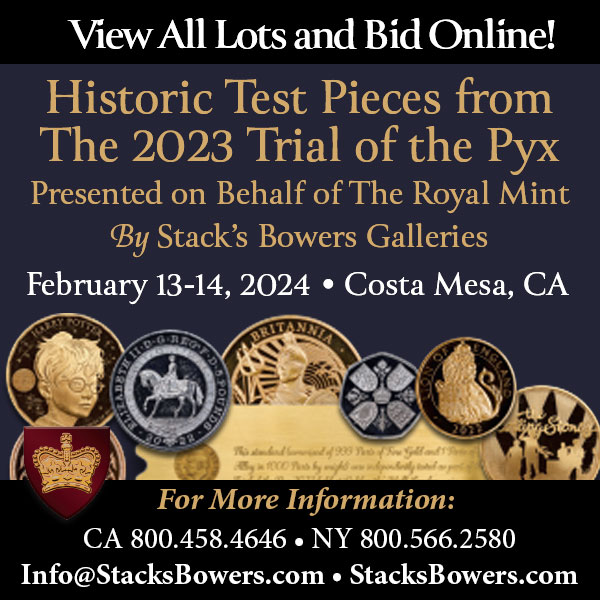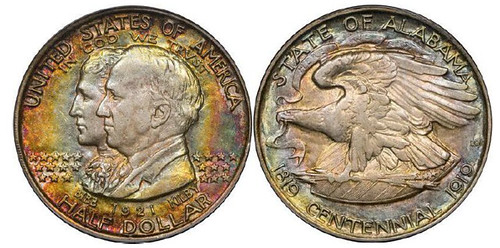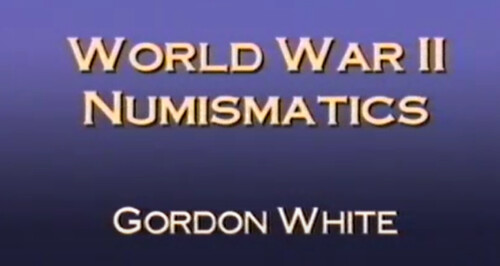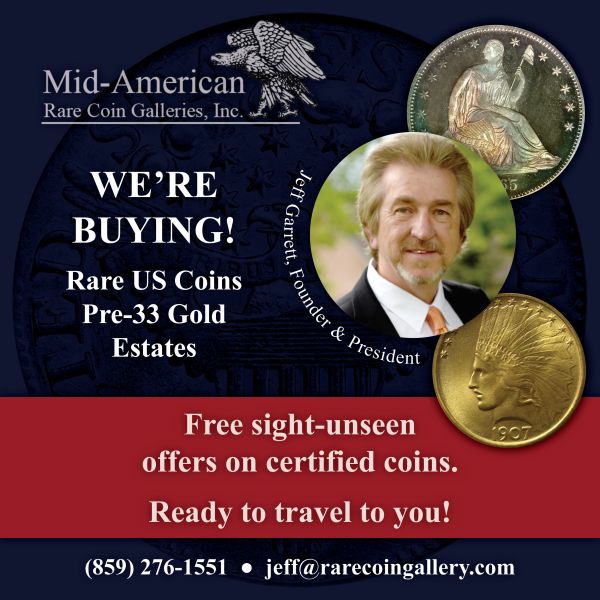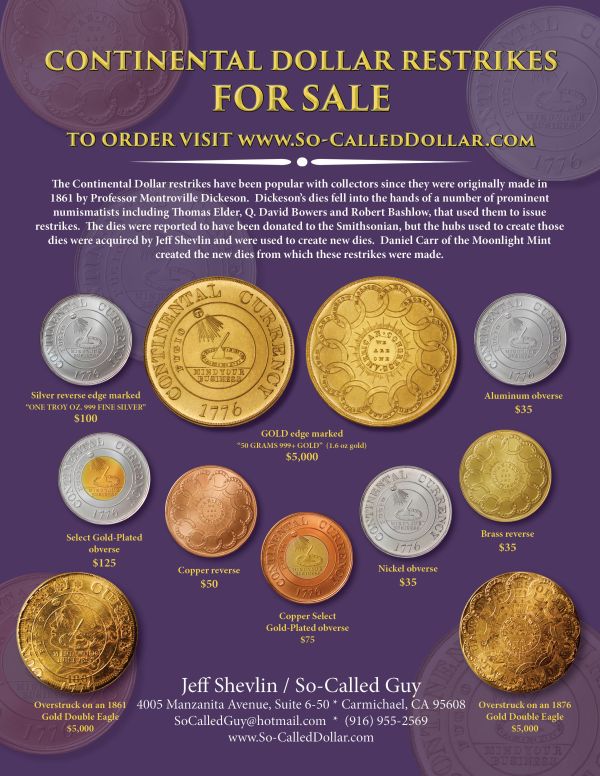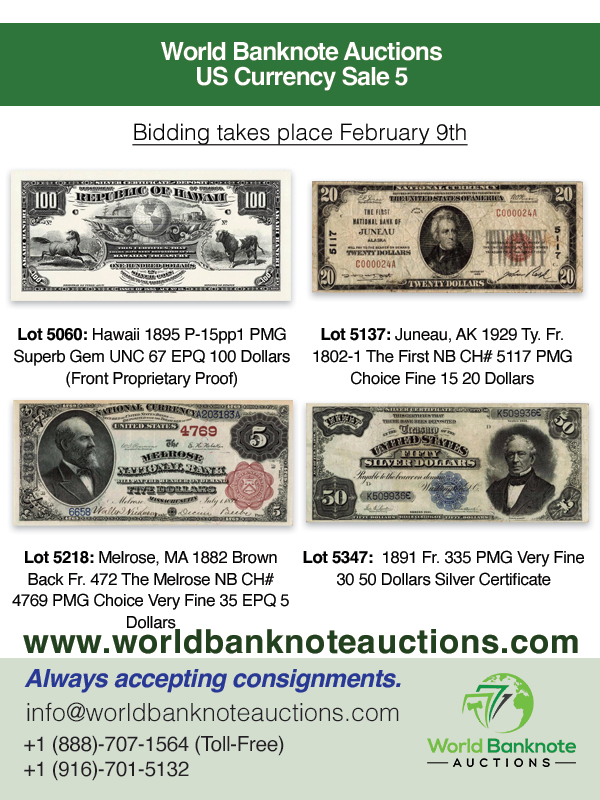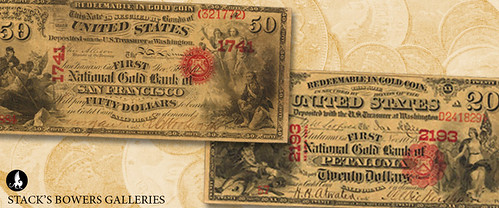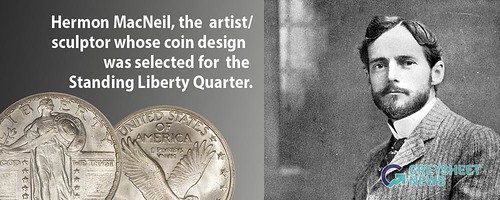
Visit our NBS Sponsors




About UsThe Numismatic Bibliomania Society is a non-profit association devoted to the study and enjoyment of numismatic literature. For more information please see our web site at coinbooks.org SubscriptionsThose wishing to become new E-Sylum subscribers (or wishing to Unsubscribe) can go to the following web page link MembershipThere is a membership application available on the web site Membership Application To join, print the application and return it with your check to the address printed on the application. Print/Digital membership is $40 to addresses in the U.S., and $60 elsewhere. A digital-only membership is available for $25. For those without web access, write to: Jeff Dickerson, Treasurer AsylumFor Asylum mailing address changes and other membership questions, contact Jeff at this email address: treasurer@coinbooks.org SubmissionsTo submit items for publication in The E-Sylum, write to the Editor at this address: whomren@gmail.com BUY THE BOOK BEFORE THE COINSale Calendar |
- WAYNE'S WORDS: THE E-SYLUM FEBRUARY 4, 2024
- MORE KOLBE & FANNING BCD LIBRARY HIGHLIGHTS
- FRANK ROBINSON AND BCD
- NEW BOOK: U.S. DIMES 1792-1837
- NEW BOOK: GROVE'S MEDALS OF MEXICO, 3RD ED.
- NEW BOOK: USA PRESSED PENNY MACHINES
- DONALD ERLENKOTTER (1938-2024)
- HARRY W. GARRISON II (1941-2024)
- GENE BRANDENBURG (1942-2024)
- RESEARCH ON U.S. CLASSIC COMMEMORATIVES
- VIDEO: WORLD WAR II NUMISMATICS
- ALEXANDER HAMILTON AND SILVER FINENESS
- MORE ON WILLIAM SUMMER APPLETON
- NOTES FROM E-SYLUM READERS: FEBRUARY 4, 2024
- THE POLITEST AUCTION THAT EVER WAS HELD
- VOCABULARY TERM: PARCEL-GILT
- WILLIAM FRANCIS SNEED JR. (1912-1979)
- NUMISMAGRAM MEDAL SELECTIONS: FEBRUARY 4, 2024
- WBNA US CURRENCY SALE FIVE HIGHLIGHTS
- NUMISMATIC NUGGETS: FEBRUARY 4, 2024
- GEORGE OHR: THE MAD POTTER OF BILOXI
- THE NATIONAL GOLD BANKS
- COIN GIFT HOLDERS
- SOTHEBY'S REVAMPS BUYER'S PREMIUMS
- LOOSE CHANGE: FEBRUARY 4, 2024
Content presented in The E-Sylum is not necessarily researched or independently fact-checked, and views expressed do not necessarily represent those of the Numismatic Bibliomania Society.
WAYNE'S WORDS: THE E-SYLUM FEBRUARY 4, 2024
 The new short version of the mailing has proved a success, reaching all of our subscribers. The original full version continues to cause problems for many, and with this week's issue we've stopped sending it out.
As always, let me know if you have any questions or problems.
The new short version of the mailing has proved a success, reaching all of our subscribers. The original full version continues to cause problems for many, and with this week's issue we've stopped sending it out.
As always, let me know if you have any questions or problems.
Thank you for reading The E-Sylum. If you enjoy it, please send me the email addresses of friends you think may enjoy it as well and I'll send them a subscription. Contact me at whomren@gmail.com anytime regarding your subscription, or questions, comments or suggestions about our content.
This week we open with more BCD library highlights, three new books, three obituaries, notes from readers, updates from the Newman Numismatic Portal, and more.
Other topics this week include medals of Mexico, "pressed penny" machines, U.S. commemorative coins, WWII numismatics, William Sumner Appleton's bookshop discovery, dealer William Sneed, fixed price and auction previews, National Gold Banks, coin gift holders, and buyer's premiums.
To learn more about Revue Numismatique, Don Erlenkotter, Harry Garrison, Gene Brandenburg, the fineness of the silver in early U.S. coinage, "The World’s Largest Coin Collection," the Fall of Riga medal, the mad potter of Biloxi, and the politest auction ever held, read on. Have a great week, everyone!
Wayne Homren
Editor, The E-Sylum
MORE KOLBE & FANNING BCD LIBRARY HIGHLIGHTS
Here are some additional highlights of the Kolbe & Fanning sale of the BCD Library. -Editor
Kolbe & Fanning Numismatic Booksellers will be holding our first sale of material from the extraordinary BCD Library on the coinage of antiquity on Saturday, February 17. Formed over the course of half a century, the BCD Library is known for the remarkable breadth and depth of its holdings, which focus most particularly on ancient Greek coinage. The initial auction, which can be accessed at bid.numislit.com, primarily focuses on published collections, general works, periodicals, and landmark publications.
Some highlights include:
FRANK ROBINSON AND BCD
Frank Robinson published an article about the BCD library sale on his blog, The Rational Optimist. Here's a lengthy excerpt - see the complete article online. -Editor
The BCD Numismatic Library Sale, and Human Endeavor
Coin collecting might seem a very solitary pastime; the coins themselves mere objects. Yet for me its rewards have been not just interior, intellectual (and financial), but also very human in its interactions and relationships.
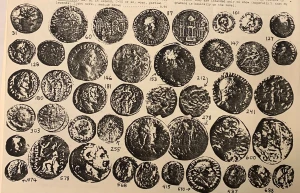 Forty years ago, I started ancient coin sales. With a xeroxed listing, illustrated by just putting a few coins on the copier. The crappiest images imaginable.
Forty years ago, I started ancient coin sales. With a xeroxed listing, illustrated by just putting a few coins on the copier. The crappiest images imaginable.
A letter from someone in Greece requested the catalog, making it sound like those few pitiful pictures were somehow important. I thought he must be a weirdo.
NEW BOOK: U.S. DIMES 1792-1837
Robert Powers has published the latest book in his series of variety & die state attribution guides. It's available from David Kahn Rare Coins. -Editor
U.S. Dimes 1792-1837 Variety Identification Guide
by Robert Powers
$95.00
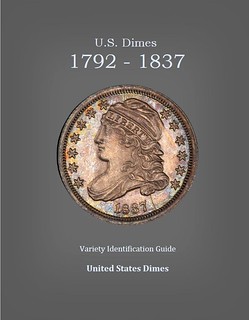 Proudly presented to you is the 8th publication of a series of variety identification guides covering Early U.S. Coins. This book covers all of the currently known die marriages of the U.S. Dimes series from 1792-1837. A complete list of all of the author’s previous publications to date are below, which are highly recommended:
Proudly presented to you is the 8th publication of a series of variety identification guides covering Early U.S. Coins. This book covers all of the currently known die marriages of the U.S. Dimes series from 1792-1837. A complete list of all of the author’s previous publications to date are below, which are highly recommended:
1. U.S. Large Cents 1793-1814 (Early Date Large Cents)
2. U.S. Large Cents 1816-1839 (Middle Date Large Cents)
3. U.S. Half Cents 1793-1857 (Complete Series)
4. U.S. Half Dollars 1794-1807 (Flowing Hair and Draped Bust)
5. U.S. Half Dollars 1807-1826 (Capped Bust Halves, Vol. 1)
6. U.S. Half Dollars 1827-1836 (Capped Bust Halves, Vol. 2)
7. U.S. Half Dimes 1792-1837 (Flowing Hair, Draped, and Capped Bust)
8. U.S. Dimes 1792-1837 (Draped Bust and Capped Bust)
9. U.S. Quarters 1796-1838 (Draped Bust and Capped Bust)
NEW BOOK: GROVE'S MEDALS OF MEXICO, 3RD ED.
Matt Ruttley writes:
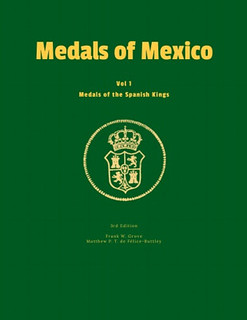 "I've been working with the family of Frank W. Grove, who wrote the standard reference on Mexican Medals - just referred to by auctioneers/slabbers as "Grove" or "Gr".
"I've been working with the family of Frank W. Grove, who wrote the standard reference on Mexican Medals - just referred to by auctioneers/slabbers as "Grove" or "Gr".
"Despite being the standard reference, they are really annoyingly inaccessible to the new collector at $850 for a set (if even available at all) as they have been out of print since the 80s. The family have given me permission to republish them so I've put together a new edition of Volume 1; Vols 2, 3, 4 and potentially Tokens book to follow.
"This new edition has updated color photos for all the medals that have sold at auction since the 80s, which is a very substantial amount. Many were previously thought to be lost and just represented by sketches or grainy black and white pics from catalogs.
"The new edition is also paperback and very affordable for new collectors at $35 (compared to at least $150-200 for the hardback original)."
NEW BOOK: USA PRESSED PENNY MACHINES
Apparently it's already out of print, but I just came across this book on elongated cent press machines around the U.S. -Editor
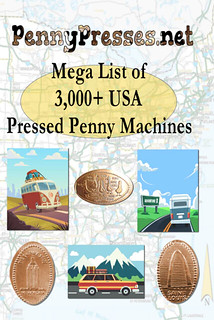 Mega List of 3,000+ USA Pressed Penny Machines
Mega List of 3,000+ USA Pressed Penny Machines
Pressed pennies have become one of the most common souvenirs purchased from our favorite museums, zoos and landmarks. With over 3,000 machines listed all over the United States, this book should become your penny “bible” and kept in the glove box of your car. Whenever you hit the road, pull out this reference and find a machine nearby.
- The perfect size to keep in your car, purse or backpack
- Over 200 pages of pressed penny machines found in every state
- Organized alphabetically by State and City
- Plenty of space for comments in the Notes section
- Easy to clean, glossy cover allows planning at meal time
- Every State is listed (including Alaska and Hawaii)
DONALD ERLENKOTTER (1938-2024)
Born August 3, 1938, Donald Erlenkotter of Santa Monica, California passed away on Sunday, January 14, 2024 aged 85. Thanks to David Gladfelter for passing the word. -Editor
David Gladfelter writes:
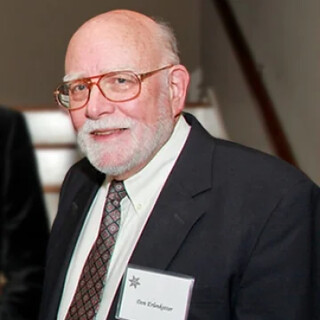 "I wanted to be sure that you knew about the passing of Donald Erlenkotter, president of the Civil War Token Society from 2009 to 2011 and a frequent contributor to its quarterly journal. He was professor emeritus of decisions, operations and technology management at the University of California at Los Angeles Anderson School of Management. His widow, Sandra Hunnicutt, said he had suffered from Alzheimer’s – this will evoke nothing but sympathy and the Society’s journal, now titled Civil War Era Numismatics to reflect its broadening focus beyond tokens, is planning a special issue later this year about him."
"I wanted to be sure that you knew about the passing of Donald Erlenkotter, president of the Civil War Token Society from 2009 to 2011 and a frequent contributor to its quarterly journal. He was professor emeritus of decisions, operations and technology management at the University of California at Los Angeles Anderson School of Management. His widow, Sandra Hunnicutt, said he had suffered from Alzheimer’s – this will evoke nothing but sympathy and the Society’s journal, now titled Civil War Era Numismatics to reflect its broadening focus beyond tokens, is planning a special issue later this year about him."
HARRY W. GARRISON II (1941-2024)
New Jersey dealer Harry Garrison has passed. Here's an excerpt from his online obituary. -Editor
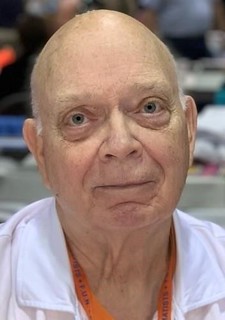 Harry (Bud) W. Garrison, 82, of Cream Ridge, passed away Wednesday, January 3, 2024 from pancreatic cancer. Born in Trenton, Harry graduated from Hamilton High East and Marywood College and served in the US Army. He worked for McGraw Hill for 38 years, retiring in 2000. An avid coin collector, Harry turned his hobby into a career when he opened Colonial Valley Coins in Yardville. He sold the business in 2023. He was a long-time member of the Trenton Numismatic Club. Harry also enjoyed fishing, boating, and trips to "the lake" in Canada.
Harry (Bud) W. Garrison, 82, of Cream Ridge, passed away Wednesday, January 3, 2024 from pancreatic cancer. Born in Trenton, Harry graduated from Hamilton High East and Marywood College and served in the US Army. He worked for McGraw Hill for 38 years, retiring in 2000. An avid coin collector, Harry turned his hobby into a career when he opened Colonial Valley Coins in Yardville. He sold the business in 2023. He was a long-time member of the Trenton Numismatic Club. Harry also enjoyed fishing, boating, and trips to "the lake" in Canada.
Son of the late Harry and Ruth Garrison, he was predeceased by his brother, Robert Garrison. Harry is survived by his loving wife of 62 years, Judith A. Garrison, his children, Deborah Garrison, Wesley Garrison and his wife, Veronica, Jacob Garrison and his wife, Melissa, and Asia Garrison; his grandsons, Jacob Garrison, William Garrison, Connor Guarniere, and Chase Garrison; his sister, Lorraine Wilson and her husband, Lynn as well as many nieces and nephews.
GENE BRANDENBURG (1942-2024)
Dave Schenkman notified me that our good friend Gene Brandenburg has passed. Born May 5, 1942, he was 81. -Editor
Dave writes:
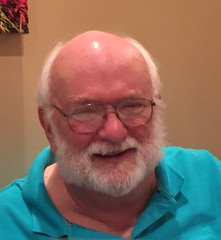 "I was saddened to learn that my friend of many years, Gene Brandenburg, died on January 31 at the age of 81, following a battle with cancer. I met Gene shortly after moving to Maryland in 1970, and we became good friends. We both eventually became coin dealers, and although we were never in business together, we shared tables at many Washington area conventions. I have fond memories of collections we purchased jointly, but the most memorable of them had nothing to do with coins; it was a group of 68 old slot machines we bought and sold the same day.
"I was saddened to learn that my friend of many years, Gene Brandenburg, died on January 31 at the age of 81, following a battle with cancer. I met Gene shortly after moving to Maryland in 1970, and we became good friends. We both eventually became coin dealers, and although we were never in business together, we shared tables at many Washington area conventions. I have fond memories of collections we purchased jointly, but the most memorable of them had nothing to do with coins; it was a group of 68 old slot machines we bought and sold the same day.
"Gene was a very generous person. I recall one year when he pulled up to my garage unexpectedly, honked his horn and told me to open the door. I did so, and he unloaded a dozen cases of Christian Moerlein, a Cincinnati beer that he knew I liked. The beer wasn’t sold locally, but somehow he found it; he really enjoyed surprising friends with gifts.
"Old Town Coin and Jewelry Exchange, Gene’s shop was a fixture of Alexandria, Virginia for decades. He loved to buy unusual items, so there was always something new when I stopped by. He loved the business, and even after closing his shop he maintained a presence in Alexandria by renting space in an antique mall, where he could be found a couple of days a week.
"Gene was a member of Nummis Nova, a dinner group that meets monthly, and we always drove to the restaurants together. The return trips usually included conversations about the items passed around by members, and no matter whether they were U.S. and foreign coins, or tokens, medals, and obsolete currency, if they were unusual or rare Gene was interested in them.
"My wife, Joanne, and I were often guests at his home for his family’s Thanksgiving dinner, and we treasure these memories. Gene was a very special person, and he will be missed."
RESEARCH ON U.S. CLASSIC COMMEMORATIVES
The latest additions to the Newman Numismatic Portal are research monographs on U.S. commemorative coins by Lee Gast. Project Coordinator Len Augsburger provided the following report. -Editor
Lee Gast Delivers Research on U.S. Classic Commemoratives 206258094)
The constantly progressing availability of information demands the reexamination of old subjects, and, in the realm of U.S. classic commemoratives (1892-1954), Lee Gast has stepped into the void and is producing monographs on the various issues in the series. The recently added Alabama Centennial (1921) installment is typical. Gast pulls documentation from congressional proceedings, the Commission of Fine Arts, and the National Archives, creating a full picture of the coin from conception to realization. The original documents provide authoritative context, and collectors of the series will appreciate the stories behind each individual commemorative issue.
Image: 1921 Alabama Centennial half dollar, Plain variety. Ex. Lee Gast Collection, photography by Mark Goodman.
VIDEO: WORLD WAR II NUMISMATICS
The David Lisot Video Library on the Newman Numismatic Portal can be found at:
https://nnp.wustl.edu/library/multimediadetail/522852
We highlight one of his videos each week in The E-Sylum. Here's one from 1995 about World War II Numismatics. -Editor
ALEXANDER HAMILTON AND SILVER FINENESS
Craig Sholley and Harry Salyards submitted this article about their recent research into the fineness of the silver in early U.S. coinage. Thank you. -Editor
Craig Sholley and Harry Salyards
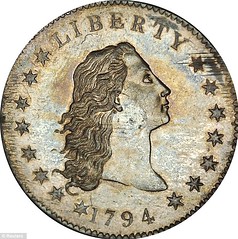 Alexander Hamilton has been criticized by numerous past and present authors for supposedly choosing a wrong gold-to-silver ratio and a wrong standard for the grains of fine silver in a dollar; the latter leading to a clumsy fineness of .8924 for our early silver coinage. One 19th century author was apparently also the source of the tale that while U.S. dollars were significantly lighter than the Spanish dollar, their trading on par in the West Indies led to large deposits of Spanish dollars at the U.S. Mint for recoinage at a profit.
Alexander Hamilton has been criticized by numerous past and present authors for supposedly choosing a wrong gold-to-silver ratio and a wrong standard for the grains of fine silver in a dollar; the latter leading to a clumsy fineness of .8924 for our early silver coinage. One 19th century author was apparently also the source of the tale that while U.S. dollars were significantly lighter than the Spanish dollar, their trading on par in the West Indies led to large deposits of Spanish dollars at the U.S. Mint for recoinage at a profit.
Early this year, Harry Salyards and I began researching these points and found both the criticism and the supposed arbitrage trade completely without merit. Not only did the authors criticizing Hamilton use incorrect period gold-to-silver ratios, along with incorrect weights and fineness standards for the Spanish dollars of the early 1790s, they often used assay figures for either earlier or later date Spanish dollars. And, even then, the data were often misquoted or misrepresented.
MORE ON WILLIAM SUMMER APPLETON
Chester Sullivan submitted these notes to add to our discussion of collector William Summer Appleton. Thank you. -Editor
Edith Pilcher's seminal book Castorland—French Refugees in the Western Adirondacks 1793-1814 is a reliable source of Castorland materials. She summarized Hough's translation of Journal of Castorland, which includes the New York company's Constitution. Numismatists have relied on this paragraph in the Constitution.
"The commissaries in Paris shall receive no salary. In recognition of the care which they may bestow upon the common concerns there shall be given them an attendance fee, droit de presence, for each special or general assembly where they may meet on the affairs of the company. This fee is fixed at two Jetons of silver of the weight of 4 to 5 gros. The jetons shall be made at the expense of the company, under the direction of the commissaires, who shall decide upon their form and design." Heading 5, Article 9 of the Constitution.
NOTES FROM E-SYLUM READERS: FEBRUARY 4, 2024
Holabird On Friends, Life and Death
Fred Holabird writes:
"So often, we never get input on what we do. I absolutely love the job you do, and have since you invented it. Your coverage is wonderful, attempting to cover all aspects of numismatics.
"Interestingly, of late folks have really commented on my “obits” – I bring this up because of your inclusion of my note on Rex Stark last week.
"I started writing these years ago for one simple reason. I love the people I write about. They have been part of my life, and I feel it necessary to share experiences with everybody. Most folks that read them don’t know the guys, but many do. They enjoy the personal experiences I try to relate. When they go, it hits you in the gut. It makes you realize that we are all on “that list” and it's getting closer.
"Anyway, thanks. I'm sure you don’t get that enough, but you sure as hell will from me."
Thanks, Fred. We have three new obits in this issue, one for a dear local friend. It's always a kick in the gut to lose someone like that. All we can do is stop and remember, then keep on keepin' on. -Editor
To read the earlier E-Sylum article, see:
NOTES FROM E-SYLUM READERS: JANUARY 28, 2024 : Fred Holabird Remembers Rex Stark
(https://www.coinbooks.org/v27/esylum_v27n04a14.html)
Other topics this week include regional Dansco albums, and U.S. Coin Collection Completeness. -Editor
THE BOOK BAZARRE
THE POLITEST AUCTION THAT EVER WAS HELD
Julia Casey writes:
"I found this last night and thought readers might like it. It's an entertaining read from a New York Times reporter who covered the Thomas Elder sale held on September 30, 1905. This article appeared in the October 1, 1905 issue. Attached is my transcription."
Thank you! Great find. -Editor
THAT EVER WAS HELD
______
A $2,500 Sale of Curios at the
Collectors’ Club
______
AND NOT A CROSS WORD
______
Bidders All on Friendly Terms and a
Model Auctioneer—Some of
the Prizes
____
VOCABULARY TERM: PARCEL-GILT
Here's another entry from Dick Johnson's Encyclopedia of Coin and Medal Terminology. I added an image of an ungilt version of the mentioned medal submitted by Dave Schenkman for an earlier article. Thanks again! Dave notes that "It is iron and not gilt, and I've never seen one that was gilt." -Editor
Parcel-gilt. Partly gilt; goldplated only on a part of a medallic item for the effect of a contrast of metals or their color. Parcel-gilt usually refers to objects that were originally firegilded – those that were only partially gilded in the first place, or were a part of this original gilding has worn off. Firegilding applied only a very thin layer of gold and this was susceptible to wearing away under many conditions (as being carried about or a container that abraded the piece). Parcel-gilt was applied to both base metal and precious metal items, often silver goldplate (vermeil); the contrast of silver sheen with a gold color, or both silver and gold on the same item was the effect their creator was trying to obtain.
WILLIAM FRANCIS SNEED JR. (1912-1979)
E-Sylum Feature Writer and American Numismatic Biographies author Pete Smith submitted this article on Florida coin dealer and promoter William Sneed. Thanks! -Editor
This week I was intrigued by an ad in The Orlando Sentinel for September 10, 1953. It invited me to “See The World’s Largest Coin Collection” and to meet “WORLD FAMOUS COIN COLLECTOR” William E. Sneed. I was somewhat skeptical that his collection may not have been the world’s largest. I also suspect his status as a “World Famous Coin Collector” was extravagant self-promotion.
Since the event had been over for seventy years, I had to be content reading about Mr. Sneed. I was able to find plenty of newspaper articles about him.
William Francis Sneed, Jr. was born in Florida on December 5, 1912.
NUMISMAGRAM MEDAL SELECTIONS: FEBRUARY 4, 2024
Jeremy Bostwick with Numismagram forwarded these four medals from his most recent upload of new material to his site. For all of the new items, please visit https://www.numismagram.com/inventory. -Editor
102639 | FRANCE. Paris. International Expo bronze Award Medal. Issued 1900 as the official prize [awarded to F. Zerhau] (63mm, 101.66 g, 12h). By J.-C. Chaplain at the Paris mint. REPUBLIQUE FRANÇAISE, bust of Marianne right, wearing oak wreath; oak tree to left; cityscape of Paris in background to right // EXPOSITION UNIVERSELLE INTERNATIONALE, Victory flying left, head upturned right, holding wreath and palm frond, and bearing victor, holding torch, upon her back; view of the expo hall in background; in exergue, cartouche with F. ZERHAU. Edge: «cornucopia» BRONZE. Button 29; Wurzbach 7193. Choice Mint State. Olive-brown surfaces. $295.
Visited by more than 50 million visitors, the 1900 Paris World's Fair, styled in French as the Exposition Universelle, ran from 14 April to 12 November, occurring in conjunction with the games of the II Olympiad—also held in Paris. The theme of the expo was a celebration of the century that was and the century that would be. Some of the technological advancements that were exhibited included the diesel engine, electric cars, talking films, and dry cell batteries, with Art Nouveau given a spotlight and being introduced to the world.
To read the complete item description, see:
102639 | FRANCE. Paris. International Expo bronze Award Medal.
(https://www.numismagram.com/product-page/102639)
WBNA US CURRENCY SALE FIVE HIGHLIGHTS
The World Banknote Auctions U.S. Currency Sale 5 bidding begins February 9, 2024 at 10 AM PST. Consignment Director Ryan Baum sent along these highlights and comments. -Editor
Ryan writes:
"Colonial Currency has become popular again as we look ahead to our nation's 250th birthday in a couple of years. Although we have handled several Colonials, we have an unusual uncut New Jersey sheet of mixed denominations. This is not a remainder as all notes are signed and serial-numbered. We tried to figure out the logic behind the denominations and how it aggregates to a total value of 3 Pounds, 3 Schillings. Could the extra Schillings represent a 5% fee to the printer when cut?"
New Jersey March 25, 1776 Fr. NJ-175-180 PMG Extremely Fine 40 1/- to 15/- Shillings (Uncut Sheet)
Extremely Rare and Historic Uncut Sheet of 12 from New Jersey Issue of March, 1776.
NUMISMATIC NUGGETS: FEBRUARY 4, 2024
Here's a selection of interesting or unusual items I came across in the marketplace this week. Tell us what you think of some of these. -Editor
Titus Sestertius
Titus, 79-81. Sestertius (Ae, 34.34 mm, 25.73 g) uncertain mint, Rome or Thrace, 80-81. IMP T CAES DIVI VESP F AVG P M TR P P P COS VIII. Laureate head of Titus right. Rev. Mars nude, wearing flowing cloack on the left shoulder and crested helmet, advancing right with the right leg onward, holding long spear in the right hand and trophy in the left hand over the shoulder, S C to left and right sides. RIC II.1, 499. RPC II, 502. Cohen 203 corr; BMCRE 310. Dark patina. Extremely Fine
From the February 2024 Astarte Web Auction 3. Interesting reverse design with a single striding figure. -Editor
To read the complete lot description, see:
Titus, 79-81. Sestertius
(https://www.biddr.com/auctions/astarte/browse?a=4267&l=5045661)
Other topics this week include the Swiss-French Solothurn Alliance Renewal medal, a De La Rue Advertising Note, and the Super Bowl LVIII Flip Coin. -Editor
GEORGE OHR: THE MAD POTTER OF BILOXI
We've periodically highlighted the interesting and unusual numismatic work of George E. Ohr - his six "double-sided clay coins bearing pictures, words, and numbers combined to form twelve messages, all crudely sexual." A new Smithsonian article delves into Ohr's history and a new museum showcasing his pottery work. -Editor
Just a few blocks from shore, a five-story wooden “pagoda” labeled “BILOXI ARTPOTTERY” towered above the train tracks that ran across Delauney Street. Approaching it, a visitor saw hand-lettered signs. One read: “Get a Biloxi Souvenir, Before the Potter Dies, or Gets a Reputation.” Another proclaimed: “Unequaled unrivaled—undisputed— GREATEST ARTPOTTERON THE EARTH.” Stepping inside, a curious tourist found a studio overflowing with pots. But they were not your garden variety. These pots featured rims that had been crumpled like the edges of a burlap bag. Alongside them were pitchers that seemed deliberately twisted and vases warped as if melted in the kiln. And colors! In contrast to the boring beiges of Victorian ceramics, these works exploded with color—vivid reds juxtaposed with gunmetal grays; olive greens splattered across bright oranges; royal blues mottled on mustard yellows. The entire studio seemed like some mad potter’s hallucination, and standing in the middle of it all was the mad potter himself.
 Viewed from a distance across his cluttered shop, George Ohr didn’t look mad. With his huge arms folded across his dirty apron, he looked more blacksmith than potter. But as they got a bit closer, customers could glimpse the 18-inch mustache he had wrapped around his cheeks and tied behind his head. And there was something in Ohr’s eyes—dark, piercing and wild—that suggested, at the very least, advanced eccentricity. If the pots and the man’s appearance did not prove lunacy, his prices did. He wanted $25—the equivalent of about $500 today—for a crumpled pot with wacky handles. “No two alike,” he boasted, but to most customers each looked as weird as the next. No wonder that as the new century began, thousands of the colorful, misshapen works collected dust on Ohr’s shelves, leaving the potter mad, indeed, at a world that failed to appreciate him. “I have a notion . . . that I am a mistake,” he said in an interview in 1901. Yet he predicted, “When I am gone, my work will be praised, honored, and cherished. It will come.”
Viewed from a distance across his cluttered shop, George Ohr didn’t look mad. With his huge arms folded across his dirty apron, he looked more blacksmith than potter. But as they got a bit closer, customers could glimpse the 18-inch mustache he had wrapped around his cheeks and tied behind his head. And there was something in Ohr’s eyes—dark, piercing and wild—that suggested, at the very least, advanced eccentricity. If the pots and the man’s appearance did not prove lunacy, his prices did. He wanted $25—the equivalent of about $500 today—for a crumpled pot with wacky handles. “No two alike,” he boasted, but to most customers each looked as weird as the next. No wonder that as the new century began, thousands of the colorful, misshapen works collected dust on Ohr’s shelves, leaving the potter mad, indeed, at a world that failed to appreciate him. “I have a notion . . . that I am a mistake,” he said in an interview in 1901. Yet he predicted, “When I am gone, my work will be praised, honored, and cherished. It will come.”
THE NATIONAL GOLD BANKS
Stack's Bowers Currency Auction Associate Bradley C. Trotter published an article about the National Gold Bank notes. -Editor
In the western United States, specifically California, hard money remained the norm in commerce, even after paper money had become more acceptable in the East and Midwest. Silver and gold were king, and other forms of currency that circulated in the East found no welcome in California. Distrust among the early pioneers that came seeking their fortunes in the gold fields of California directly influenced the prohibition of banks and other institutions from issuing paper money in the state.
However, in 1870 a compromise was made at the federal level, one that reflected the hard money preferences of California and the West Coast. The Currency Act of July 12, 1870, authorized the creation of special National Gold Banks that had the authority to issue National Bank Notes redeemable in gold coin. From 1871 through 1883 a total face value of $3,465,240 across almost 200,000 notes was issued to 10 banks in California and Massachusetts.
COIN GIFT HOLDERS
On the PCGS site, Victor Bozarth published an article about Coin Gift Holders. Here's an excerpt; see the complete article online. The image shows gift boxes intended for holding gold coins. -Editor
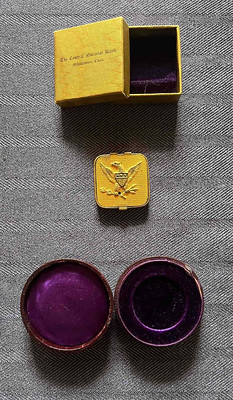 In the past I’ve written about the importance of original packaging on numismatic merchandise. What about the gift boxes, cards, envelopes, and other mediums used when gifting a coin?
In the past I’ve written about the importance of original packaging on numismatic merchandise. What about the gift boxes, cards, envelopes, and other mediums used when gifting a coin?
The boxes, cards, and envelopes that coins were originally gifted in are also of immense importance – and sometimes collector value! Not only were a great many of these packaging items disposed of over the decades, but also the process of discarding this packaging left the coin(s) inadvertently damaged.
Much like original U.S. commemorative coin packaging has value, these coin-related items are highly collectible, and some are quite valuable too.
I’ve managed to prevent the original U.S. commemorative packaging from being disposed of numerous times with just this warning. Was that important? Here’s the deal: it is not just the packaging that might be valuable, but also the information that packaging might provide us.
SOTHEBY'S REVAMPS BUYER'S PREMIUMS
Axios reports on a major change in auction price structure announced by Sotheby's. I've never cared much for the gimmick of Buyer's fees, although it's a minor inconvenience for bidders who don't mind the math. Time will tell if competitors and markets in general follow Sotheby's lead. See the complete article online for more, particularly if you're a seller. -Editor
 The single most annoying and opaque aspect of buying and selling items at auction is about to get a lot more pleasant and transparent — at least at Sotheby's, which unveiled a major transformation of its commission structure on Thursday.
The single most annoying and opaque aspect of buying and selling items at auction is about to get a lot more pleasant and transparent — at least at Sotheby's, which unveiled a major transformation of its commission structure on Thursday.
Why it matters: Buyers and sellers alike have been frustrated for decades at the way in which the amount they end up paying (or receiving) can differ significantly from the hammer price in the auction room.
- Those differences — effectively, the amount of the transaction that Sotheby's takes for itself — have risen steadily over the years. Now, they are going to fall to a multi-decade low after May 20.
- Thursday's announcement from Sotheby's represents a major reset — and is likely to put huge pressure on Christie's to follow suit. (Christie's declined to comment to Axios on what they may or may not do.)
LOOSE CHANGE: FEBRUARY 4, 2024
Here are some additional items in the media this week that may be of interest. -Editor
Michael Garofalo published a Greysheet Featured Article about the creation of Hermon Atkins MacNeil’s Standing Liberty Quarter. Here's an excerpt - see the complete article online. -Editor
Some numismatic dealers and researchers like to infer that Standing Liberty Quarters, struck between 1916 and 1930, is shrouded in a veil of mystery or controversy. Let’s explore these so-called controversies to see if they have withstood the test of time.
In 1916, there were three coins—the current and circulating Dime, Quarter, and Half Dollar—that each had been struck for 25 years. The U.S. Mint’s Chief Engraver, Charles E. Barber, had designed all of them. Each of Barber’s coin denominations shared the same obverse, and the reverse of the Quarter and Half Dollar shared a common reverse. The Dime had a much simpler reverse but none of the designs were awe-inspiring, even by 19th Century standards.
The Mint Director had invited a number of accomplished artists to offer new and more artistically beautiful designs than Barber’s stodgy Miss Liberty. Of all of the designs submitted for the three coins, the works of two sculptors were selected for these three coins. Adolph A. Weinmans’ designs were chosen for the Dime (Mercury Dime) and for the Half Dollar (Walking Liberty). Hermon Atkins MacNeil’s design was selected for the Quarter. The selections were chosen by Treasury Department officials in February of 1916.
MacNeil was born in Massachusetts in 1866. Early in his artistic career he studied art in Paris and, after winning an art scholarship, he went to Rome for further study. MacNeil was primarily a sculptor and he created numerous life size sculptures of Native Americans in order to portray events in their lives.
To read the complete article, see:
The Controversial Standing Liberty Quarters
(https://www.greysheet.com/news/story/the-controversial-standing-liberty-quarters)
Other topics this week include a Dream Library. -Editor


